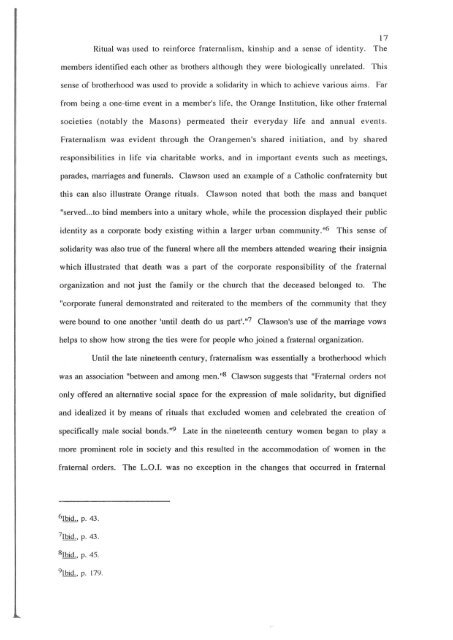TRANSPLANTED IRISH INSTITUTIONS - University of Canterbury
TRANSPLANTED IRISH INSTITUTIONS - University of Canterbury
TRANSPLANTED IRISH INSTITUTIONS - University of Canterbury
Create successful ePaper yourself
Turn your PDF publications into a flip-book with our unique Google optimized e-Paper software.
17<br />
Ritual was used to reinforce fraternalism. kinship and a sense <strong>of</strong> identity. The<br />
members identified each other as brothers although they were biologically unrelated. This<br />
sense <strong>of</strong> brotherhood was used to provide a solidarity in which to achieve various aims. Far<br />
from being a one-time event in a member's life. the Orange Institution, like other fraternal<br />
societies (notably the Masons) permeated their everyday life and annual events.<br />
Fraternalism was evident through the Orangemen's shared initiation, and by shared<br />
responsibilities in life via charitable works, and in important events such as meetings,<br />
parades, marriages and funerals. Clawson used an example <strong>of</strong> a Catholic confraternity but<br />
this can also illustrate Orange rituals. Clawson noted that both the mass and banquet<br />
"served ... to bind members into a unitary whole, while the procession displayed their public<br />
identity as a corporate body existing within a larger urban community. "6<br />
This sense <strong>of</strong><br />
solidarity was also true <strong>of</strong> the funeral where all the members attended wearing their insignia<br />
which illustrated that death was a part <strong>of</strong> the corporate responsibility <strong>of</strong> the fraternal<br />
organization and not just the family or the church that the deceased belonged to.<br />
The<br />
"corporate funeral demonstrated and reiterated to the members <strong>of</strong> the community that they<br />
were bound to one another 'until death do us part'."7 Clawson's use <strong>of</strong> the marriage vows<br />
helps to show how strong the ties were for people who joined a fraternal organization.<br />
Until the late nineteenth century, fraternalism was essentially a brotherhood which<br />
was an association "between and among men. "8 Clawson suggests that "Fraternal orders not<br />
only <strong>of</strong>fered an alternative social space for the expression <strong>of</strong> male solidarity, but dignified<br />
and idealized it by means <strong>of</strong> rituals that excluded women and celebrated the creation <strong>of</strong><br />
specifically male social bonds."9 Late in the nineteenth century women began to play a<br />
more prominent role in society and this resulted in the accommodation <strong>of</strong> women in the<br />
fraternal orders. The L.O.1. was no exception in the changes that occurred in fraternal<br />
6Ibid .. p. 43.<br />
7Ibid .. p. 43 .<br />
8Ibid .. p. 45.<br />
9Ibid .• p. 179.
















